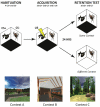Revealing context-specific conditioned fear memories with full immersion virtual reality
- PMID: 22069384
- PMCID: PMC3209582
- DOI: 10.3389/fnbeh.2011.00075
Revealing context-specific conditioned fear memories with full immersion virtual reality
Abstract
The extinction of conditioned fear is known to be context-specific and is often considered more contextually bound than the fear memory itself (Bouton, 2004). Yet, recent findings in rodents have challenged the notion that contextual fear retention is initially generalized. The context-specificity of a cued fear memory to the learning context has not been addressed in the human literature largely due to limitations in methodology. Here we adapt a novel technology to test the context-specificity of cued fear conditioning using full immersion 3-D virtual reality (VR). During acquisition training, healthy participants navigated through virtual environments containing dynamic snake and spider conditioned stimuli (CSs), one of which was paired with electrical wrist stimulation. During a 24-h delayed retention test, one group returned to the same context as acquisition training whereas another group experienced the CSs in a novel context. Unconditioned stimulus expectancy ratings were assayed on-line during fear acquisition as an index of contingency awareness. Skin conductance responses time-locked to CS onset were the dependent measure of cued fear, and skin conductance levels during the interstimulus interval were an index of context fear. Findings indicate that early in acquisition training, participants express contingency awareness as well as differential contextual fear, whereas differential cued fear emerged later in acquisition. During the retention test, differential cued fear retention was enhanced in the group who returned to the same context as acquisition training relative to the context shift group. The results extend recent rodent work to illustrate differences in cued and context fear acquisition and the contextual specificity of recent fear memories. Findings support the use of full immersion VR as a novel tool in cognitive neuroscience to bridge rodent models of contextual phenomena underlying human clinical disorders.
Keywords: contextual fear; fear conditioning; hippocampus; memory retention; virtual reality.
Figures




Similar articles
-
Human fear conditioning conducted in full immersion 3-dimensional virtual reality.J Vis Exp. 2010 Aug 9;(42):1993. doi: 10.3791/1993. J Vis Exp. 2010. PMID: 20736913 Free PMC article.
-
Medial prefrontal pathways for the contextual regulation of extinguished fear in humans.Neuroimage. 2015 Nov 15;122:262-71. doi: 10.1016/j.neuroimage.2015.07.051. Epub 2015 Jul 26. Neuroimage. 2015. PMID: 26220745 Free PMC article.
-
Behavioral and central correlates of contextual fear learning and contextual modulation of cued fear in posttraumatic stress disorder.Int J Psychophysiol. 2015 Dec;98(3 Pt 2):584-93. doi: 10.1016/j.ijpsycho.2015.06.009. Epub 2015 Jul 3. Int J Psychophysiol. 2015. PMID: 26149734
-
Contextual modulation of conditioned responses in humans: A review on virtual reality studies.Clin Psychol Rev. 2021 Dec;90:102095. doi: 10.1016/j.cpr.2021.102095. Epub 2021 Oct 22. Clin Psychol Rev. 2021. PMID: 34763127 Review.
-
Serotonergic modulation of conditioned fear.Scientifica (Cairo). 2012;2012:821549. doi: 10.6064/2012/821549. Epub 2012 Oct 9. Scientifica (Cairo). 2012. PMID: 24278743 Free PMC article. Review.
Cited by
-
A translational perspective on neural circuits of fear extinction: Current promises and challenges.Neurobiol Learn Mem. 2018 Nov;155:113-126. doi: 10.1016/j.nlm.2018.07.002. Epub 2018 Jul 4. Neurobiol Learn Mem. 2018. PMID: 29981423 Free PMC article.
-
A model of amygdala-hippocampal-prefrontal interaction in fear conditioning and extinction in animals.Brain Cogn. 2013 Feb;81(1):29-43. doi: 10.1016/j.bandc.2012.10.005. Epub 2012 Nov 17. Brain Cogn. 2013. PMID: 23164732 Free PMC article.
-
Enhanced discriminative fear learning of phobia-irrelevant stimuli in spider-fearful individuals.Front Behav Neurosci. 2014 Oct 1;8:328. doi: 10.3389/fnbeh.2014.00328. eCollection 2014. Front Behav Neurosci. 2014. PMID: 25324745 Free PMC article.
-
Meaning attribution in the West African green monkey: influence of call type and context.Anim Cogn. 2014 Mar;17(2):277-86. doi: 10.1007/s10071-013-0660-9. Epub 2013 Jul 12. Anim Cogn. 2014. PMID: 23846397 Free PMC article.
-
Extinction learning is slower, weaker and less context specific after alcohol.Neurobiol Learn Mem. 2015 Nov;125:55-62. doi: 10.1016/j.nlm.2015.07.014. Epub 2015 Jul 30. Neurobiol Learn Mem. 2015. PMID: 26234587 Free PMC article.
References
Grants and funding
LinkOut - more resources
Full Text Sources

